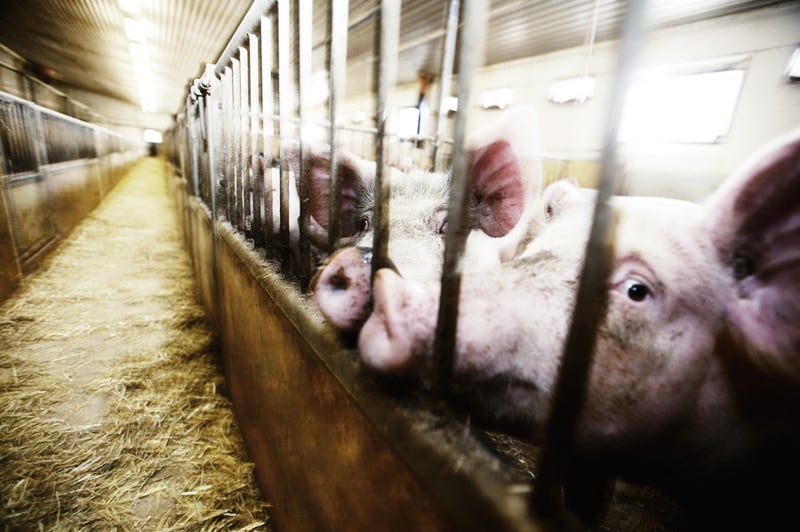
You may have seen one or more of the 9 seasons of American Horror Story (AHS) that have aired to date on FX, in which each season the ensemble cast take on new roles within a new plot based on classic horror movie and pop culture tropes. As so many very real horrors are faced by animals and people as a result of the factory farming industry, could the next season be AHS: Factory Farm?
American Horror Story has seemingly covered the gamut of classic horror topics, from haunted houses and hotels to cults and covens of witches. It has its fair share of thrills, chills, and even a bit of gore. But none of the past themes can hold a candle to the terror wrought by factory farms.
Cut tails, clipped teeth, and lasered beaks
AHS has featured at least one mad surgeon, but factory farms take the creepy cake. Just a few days after their birth, piglets “undergo a battery of procedures” that remove or alter parts of their bodies, including tooth-clipping, tail docking, and castration, typically performed without any pain relief. Chicks destined to become laying hens have part of their sensitive beaks trimmed off by infrared laser, again typically without any pain relief. These alterations are not for the animals’ health, but to adapt them to the crowded, stressful, and at times violent conditions on factory farms.
Trapped in a cage
Many horror victims find themselves trapped in concrete rooms or metal cages, encouraging us as viewers to feel their claustrophobia and panic. For pregnant pigs and egg-laying hens on factory farms, this is their reality for most of their lives. A pig raised for breeding spends her pregnancies in gestation crates, unable to turn around or lay with her legs fully extended without touching the sides or the pig confined immediately next to her. The stress and boredom cause abnormal behaviors like bar biting and obsessive chewing and the lack of movement leads to leg injuries and lameness. Laying hens are crammed into a small cage with several other birds, with several cages stacked on top of one another to fill the barn. Unable to spread their wings, scratch at the ground or dust bathe, they will peck and severely injure one another. When birds die, they can’t be easily accessed by workers, and remain at the bottom of cages exposing the other birds to disease and bacteria.
Superbugs and spreading infections
In the horror oeuvre, a spreading infection is likely the trigger for a massive zombie outbreak or an internal battle within a deteriorating character. But over the past few decades, factory farming has been slowly and steadily driving a global public health crisis: antibiotic-resistant superbugs. Antibiotics are routinely overused in factory farms to prop up low welfare practices, such as fast-growing breeds, cage confinement, surgical alterations, and overcrowding. This misuse creates conditions for bacteria to develop resistance to the medicines used to fight them and to do so at an extreme scale. Resistant bacteria readily enter the environment and our food supply, and these superbugs are considered one of the greatest public health concerns of this century. Resistant infections kill an estimated 35,000 people each year in the US alone.
Lacerations, severed appendages, and neurological disorders
Countless characters throughout the AHS seasons have endured painful, debilitating injuries, but factory farming has that covered as well. Workers in meat processing plants are three times more likely to suffer serious injury than the average worker, including increased risk of amputations and head trauma. In a 31-month period between 2015-2017, 550 serious injuries were reported, most of which involved amputation of fingers, but also included lost hands, arms, and toes. On average, the industry has two amputations per week. It’s not just physical injury. Reports have documented a rare neurological disorder among workers that process pigs, linked to exposure to aerosolized brain tissue. The risk of this disorder as well as the trauma injuries increase when processing lines are operated at fast speeds, and the industry continues to pressure the government to lift maximum speed limitations.
A lingering, ominous, odorous presence
No horror film would be complete without a looming presence that imbues the characters or location with a sense of dread, such as the run-down house at the end of the lane or the spooky cemetery. For communities living near factory farms, their presence is a constant source of horror. Toxic emissions pollute the local air and water, and tests of the dust settled on and in nearby houses show the presence of fecal matter. People living in this environment are at increased risk of respiratory illnesses, and studies have found houseflies near US poultry farms carry resistant strains of bacteria. Local residents also report increased depression, anxiety, sleep disorders, and stress.
Instead of touring a haunted house this Halloween, the real scare would be touring a factory farm. However, as the industry continuously puts up barriers to the public accessing information about what happens on these farms, “American Horror Story: Factory Farm” would sadly be the best option to keep getting the word out.
Remove your support of cruel factory farms and protect farmed animals by urging your legislator to ban factory farming.